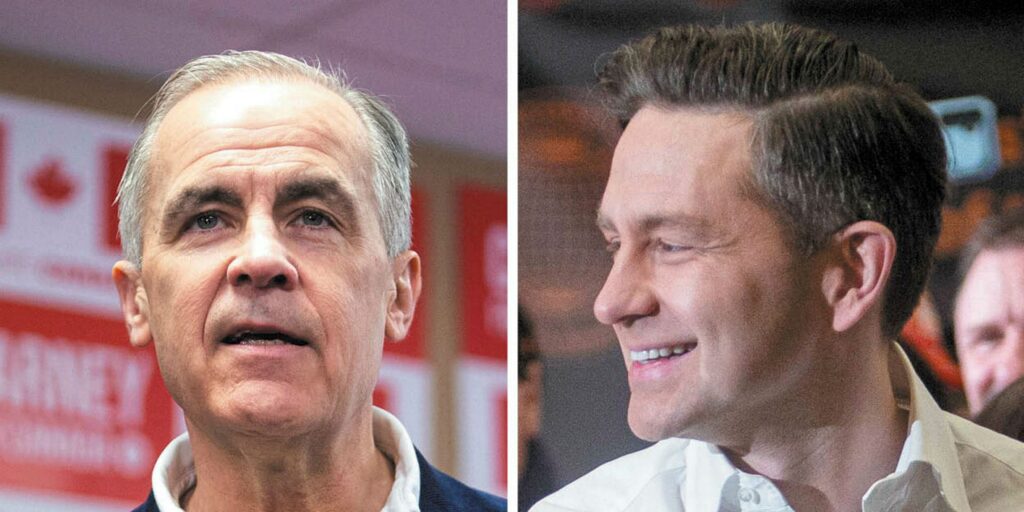No matter what, it will be a ‘change’ election for the federal public service

Published in the Hill Times on April 28, 2025
All in all, both Mark Carney and Pierre Poilievre promise fiscal restraint, but they have very expensive priorities and are planning to run deficits. Time will tell whether how much of a ‘change’ the next prime minister is from the last one.

The 10-year relationship between the public service and the government of Justin Trudeau has come to an end and both Liberal Leader Mark Carney, left, and Conservative Leader Pierre Poilievre, right, can legitimately claim to be ‘change’ candidates, writes Lori Turnbull. The Hill Times photographs by Andrew Meade
No matter what happens on April 28th, this election is gearing up to be a “change” election for the federal public service. The ten-year relationship between the public service and the government of Justin Trudeau has come to an end and both Liberal leader Mark Carney and Conservative leader Pierre Poilievre can legitimately claim to be “change” candidates. Their communication and leadership styles are very different from Trudeau’s. And, at the risk of stating the obvious, the shifting world around us would make this a “change” election even without a new government.
Carney is the incumbent but in a constitutional rather than a political sense. He became the leader of the Liberal Party on March 9th, was sworn in as prime minister on March 14th, and then called an election on March 23rd. Having no seat in the House of Commons and no mandate from the public, he had little choice. Wearing the prime ministerial hat during the campaign has likely been a help to Carney by giving him opportunities to meet with global leaders, announce decisions, and carry a sense of authority. But his time in office, almost all of it in caretaker mode, has not been long enough to get a sense of what the governing relationship between the public service and a Carney government would be like. That said, Carney and Poilievre have each given glimpses of their plans for the public service should they form government.
The Conservatives have called their platform “Change,” lest there be any confusion about how they wish to frame the ballot question. Poilievre is promising to cut the lowest personal income tax rate from 15% to 12.75%, which would cost the government roughly $75 billion. The Conservatives propose to make up this shortfall through measures including cuts to the public service, including job losses, and cutting the use of consultants by $10 billion. Mark Carney has pledged to cap the size of the public service and save $28 billion over three years by eliminating wasteful spending and changing operations. Neither plan is detailed enough to know what it really means but, either way, the public service appears to be in for some lean years. This would be a shock compared to what people have become used to under Trudeau’s leadership.
Carney and Poilievre share some key priorities that set them apart from those of the Trudeau government. For example, both Carney and Poilievre want to increase defence spending. This is no surprise given the current geopolitical climate and, if Trudeau were still in office now he might do the same thing. But these multiyear commitments are substantial and represent a significant departure from past practice in Canada and from the actions of the Trudeau government. Further, both want the federal government to build more houses, though they differ on the ways to do this. Poilievre’s plan is not wildly different from the Housing Accelerator Fund, while Carney is suggesting a whole new housing agency called Build Canada Homes to expedite the building process.
Both Carney and Poilievre have expressed commitments to fiscal anchors and maintaining a fiscally responsible approach compared to the Trudeau government. Poilievre vows to “slash the Liberal deficit” but cutting spending, including for “special interests” and by “unlocking the power of resources in homebuilding.” But it’s not clear whether this would all balance out in the end and whether savings would offset new spending. Meanwhile, Carney offers a new approach to budgeting that would separate out operational costs from investments in economic growth. He also promises not to cut transfers to provinces, despite pledging $130 billion in new spending over the next four years. Again, it’s not clear whether and how this will balance out. All in all, both Carney and Poilievre promise fiscal restraint but they have very expensive priorities and are planning to run deficits. So, time will tell whether how much of a “change” the next prime minister is from the last one.
For what it’s worth, Carney and Poilievre are both running in Ottawa-area ridings, which means their own paths to the House of Commons weave through the highest concentration of federal public servants in the country. They are both pitching “change”. One will get a mandate to give it a try.
Lori Turnbull is a senior advisor at the Institute on Governance.